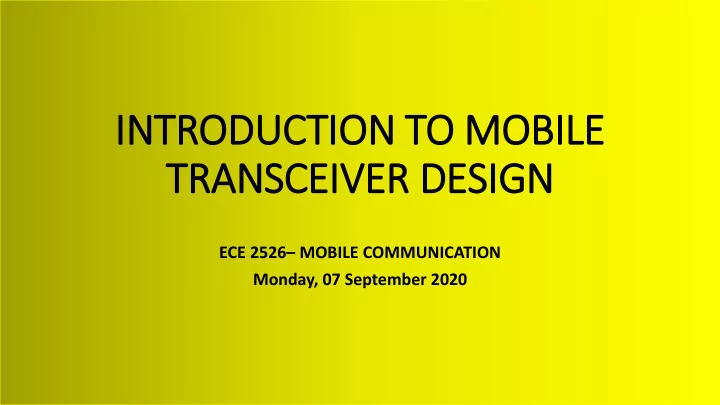

IN INTRODUCTION TO MOBILE TRANSCEIVER DESIGN ECE 2526 – MOBILE COMMUNICATION Monday, 07 September 2020
FUNCTIONS OF A TRANSMITTER The basic functions of a transmitter are: a) up-conversion: move signal to desired RF carrier frequency. b) power amplification: amplify signal to deliver wanted power to antenna for emission. The main functions of a radio receiver are: a) To intercept the RF signal by using the receiver antenna b) Select the desired RF signal and reject everything else c) Amplify the RF signal d) Detect the signal and demodulate to yield the original baseband signal e) Amplify the baseband signal
TYPES OF RADIO TRANSMITTERS Radio transmitters are basically of two types, i.e 1. Mixer-Based • Which can be Direct Conversion (Homodyne) or 2-Stage Conversion (Heterodyne) • Both architectures can operate with constant and non-constant envelope modulation • Well-suited for multi-standard operation 2. PLL-Based • Fundamentally limited to constant-envelope modulation schemes • Show promise with respect to elimination of discrete components • not suitable for multi-standard operation
MODULATION STANDARDS
DIRECT CONVERSION Direct Conversion has the following features 1. It is attractive due to simplicity of the signal path 2. It is suitable for high levels of integration 3. Output carrier frequency is same as local oscillator (LO) frequency 4. Major drawback: LO disturbance by PA output Re(X(t)) Output signal Re(x(t) 𝑩 𝒅 𝒅𝒑𝒕𝝏 𝒅 𝒖 + Im(xt)) 𝑩 𝒅 𝒅𝒑𝒕𝝏 𝒅 t Note: For frequency and phase- modulated signals, conversion must provide quadrature outputs to avoid Im(X(t)) loss of information.
DRAWBACK OF DIRECT CONVERSION 1. “Injection pulling” or “injection locking” results from the noisy output of power amplifier corrupting the output of the VCO. 2. VCO frequency shifts toward frequency of external stimulus due to the feedback. 3. If injected noise frequency is close to oscillator frequency and the noise increases, then the output “locks” onto noise frequency.
SOLUTION TO ‘LOCAL OSCILLATOR (LO) PULLING’ • LO pulling is usually minimized by moving the PA output spectrum sufficiently far from the LO frequency through a process called LO offset. • LO offset is achieved by mixing 2 VCO outputs ω 1 and ω 2 and filtering the result; leading to a carrier frequency of ω 1 + ω 2 , which is far from either ω 1 or ω 2. BPF1 Output signal must have high selectivity to Re(x(t) 𝑩 𝒅 𝒅𝒑𝒕(𝝏 𝟐 +𝝏 𝟑 )𝒖 + Im(xt)) 𝑩 𝒅 𝒅𝒑𝒕(𝝏 𝟐 + 𝝏 𝟑 )t suppress harmonics from m ω 1 +m ω 2
HOMODYNE RECEIVER 880-960 MHz 1710 – 1880 MHz
TWO-STAGE SUPERHETRODYNE • Hetrodyne conversion uses Quadrature modulation at IF (ω 1 )followed by a second up- conversion stage to yield ω 1 + ω 2 by mixing and filtering. • Advantages: Has no LO pulling; Has better I/Q matching, i.e less crosstalk between the 2 bit streams. BPF2 BPF1 removes the unwanted suppresses the IF sideband ω 1 - ω 2 harmonics
2-STAGE SUPERHETRODYNE RECEIVER
HETERODYNE RADIO TRANSMITTER WITH SINGLE IF STAGE
TRENDS IN TRANSCEIVER INTEGRATION 1. Both Direct conversion and hetrodyne architectures are used with minor modifications for better integration and multi-standard operation. 2. Direct architecture achieves a low-cost solution with a high level of integration. 3. 2-stage superhetrodyne architecture results in better performance (i.e. reduced LO pulling) at the expense of increased complexity and hence higher cost of implementation. 4. Transmitter and receiver parts of a transceiver are usually designed concurrently to enable hardware and possibly power sharing
EXAMPLE - 5-GHZ CMOS TRANSCEIVER FRONTEND CHIPSET Voltage-Controlled Oscillator on-chip quadrature VCO and buffers to improve frequency purity Duplexer Allows Buffers simultaneo isolate sensitive VCO circuits us Tx and from high-power, large voltage Rx, or current swing circuit blocks
A DUAL BAND GSM 900/1800-MHZ CMOS TRANSMITTER • Transmitter exploits similarities 𝒈 𝟐 = 𝟓𝟔𝟏 𝑵𝑰𝒜 𝒈 𝟑 = 𝟐𝟒𝟔𝟏 𝑵𝑰𝒜 of GSM 900 and 1800 standards (modulation, channel spacing, antenna duplexing) to reduce hardware • Two quadrature upconverters 𝒈 𝟐𝟗𝟏𝟏 = 𝟐𝟒𝟔𝟏 + 𝟓𝟔𝟏 driven by 450MHz LO to generate quadrature phases of IF signal. • IF signal routed to single- sideband mixers driven by a 1350MHz Local Oscillator, 𝒈 𝟘𝟏𝟏 = 𝟐𝟒𝟔𝟏 − 𝟓𝟔𝟏 producing either 900MHz or 𝒈 𝟑 = 𝟐𝟒𝟔𝟏 𝑵𝑰𝒜 1800MHz signal 𝒈 𝟐 = 𝟓𝟔𝟏 𝑵𝑰𝒜
EXAMPLES OF CMOS OSCILLATORS Crystal Crystal (a) Piece Oscillator (b) Miller Oscillator
CONVENTIONAL CMOS MIXER IF Intermediate frequency LO signal Signal from Local Oscillator LO Signal from RF Image filter
PRINCIPLE OF OPERATION OF CMOS MIXER (a) CMOS Mixer Circuit (b) Current flow in the resistors
CHALLENGES IN THE DESIGN OF TRANCEIVER INTEGRATED CIRCUITS 1. Implementation of highly integrated radio transceivers will remain as one of the greatest challenges in IC technology. 2. New architectures and circuit techniques are currently under investigation for higher flexibility in CMOS transmitters. 3. Further improvement are required in the design of on-chip inductors, filters and oscillators in a standard CMOS process. 4. There is need for continued improvement in high frequency CMOS device modelling and simulation.
PLL TRANSMITTER
Recommend
More recommend